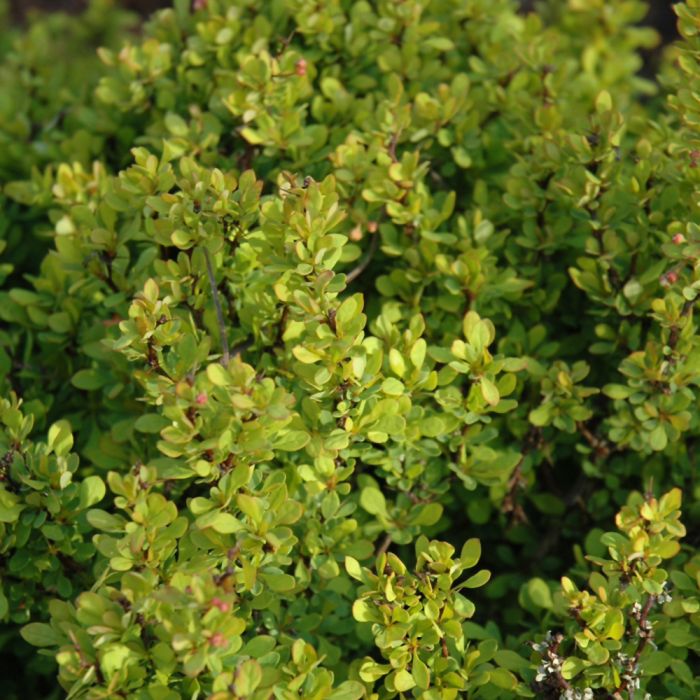Berberis, Japanese Barberry 'Golden Nugget™'



Out of stock
Coming soon, still growing- Sun Preference
- Full-Sun, Part-Sun
Description
An exceptional garden selection with a dwarf, compact habit of growth and ravishing tiny golden leaves that retain their color all season long, often with a hint of orange; an exceptional color shrub for the mixed border, can even be used as edging.
Minnesota's Largest Selection of Shrubs
Elevate your landscaping with Gertens' unmatched variety of shrubs! Selecting the right shrubs for your backyard can enhance its beauty and functionality. Consider factors like sunlight, soil type, and mature size when choosing shrubs. For sunny areas, flowering shrubs like roses or hydrangeas can add color and charm. In shady spots, opt for shrubs like azaleas or hostas. Evergreen shrubs provide year-round interest and privacy, while deciduous shrubs offer seasonal color changes. At Gertens, we offer a wide selection of shrubs to suit every backyard need.
Details
Height: 15 inches
Spread: 18 inches
Sunlight:![]()
![]()
Hardiness Zone: 4a
Description:
An exceptional garden selection with a dwarf, compact habit of growth and ravishing tiny golden leaves that retain their color all season long, often with a hint of orange; an exceptional color shrub for the mixed border, can even be used as edging
Ornamental Features
Golden Nugget Japanese Barberry has attractive yellow foliage which emerges orange in spring. The small oval leaves are highly ornamental and turn an outstanding orange in the fall. It features tiny clusters of yellow flowers hanging below the branches in mid spring. The fruits are showy scarlet drupes displayed from early to late fall.
Landscape Attributes
Golden Nugget Japanese Barberry is a dense multi-stemmed deciduous shrub with a mounded form. It lends an extremely fine and delicate texture to the landscape composition which should be used to full effect.
This is a relatively low maintenance shrub, and can be pruned at anytime. Deer don't particularly care for this plant and will usually leave it alone in favor of tastier treats. Gardeners should be aware of the following characteristic(s) that may warrant special consideration;
- Spiny
Golden Nugget Japanese Barberry is recommended for the following landscape applications;
- Mass Planting
- Rock/Alpine Gardens
- Border Edging
- General Garden Use
- Groundcover
- Container Planting
Planting & Growing
Golden Nugget Japanese Barberry will grow to be about 15 inches tall at maturity, with a spread of 18 inches. It tends to fill out right to the ground and therefore doesn't necessarily require facer plants in front. It grows at a slow rate, and under ideal conditions can be expected to live for approximately 20 years.
This shrub does best in full sun to partial shade. It is very adaptable to both dry and moist growing conditions, but will not tolerate any standing water. It is not particular as to soil type or pH, and is able to handle environmental salt. It is highly tolerant of urban pollution and will even thrive in inner city environments. This is a selected variety of a species not originally from North America.
Golden Nugget Japanese Barberry makes a fine choice for the outdoor landscape, but it is also well-suited for use in outdoor pots and containers. It is often used as a 'filler' in the 'spiller-thriller-filler' container combination, providing a mass of flowers and foliage against which the thriller plants stand out. Note that when grown in a container, it may not perform exactly as indicated on the tag - this is to be expected. Also note that when growing plants in outdoor containers and baskets, they may require more frequent waterings than they would in the yard or garden. Be aware that in our climate, most plants cannot be expected to survive the winter if left in containers outdoors, and this plant is no exception. Contact our store for more information on how to protect it over the winter months.
| SKU | Container Size |
| S0400 | #2 Container (2 Gallon) |
* Not all container sizes may be available at this time. See store for details on specific container size availability.
More Information
| Gerten Grown Plants | Gerten Grown Plants |
|---|---|
| Sun Preference | Full-Sun, Part-Sun |
| Mature Height (Range) | under 2 feet |
| USDA Hardiness Zone | 4, 5, 6, 7, 8 |
| Common Family Name | Barberry |


